DIAMOND
Diamond is a solid form of the element carbon with its atoms arranged in a crystal structure called diamond cubic. At room temperature and pressure, another solid form of carbon known as graphite is the chemically stable form, but diamond almost never converts to it. Diamond has the highest hardness and thermal conductivity of any natural material, properties that are utilized in major industrial applications such as cutting and polishing tools. They are also the reason that diamond anvil cells can subject materials to pressures found deep in the Earth.
Because the arrangement of atoms in diamond is extremely rigid, few types of impurity can contaminate it (two exceptions being boron and nitrogen). Small numbers of defects or impurities (about one per million of lattice atoms) color diamond blue (boron), yellow (nitrogen), brown (defects), green (radiation exposure), purple, pink, orange or red. Diamond also has relatively high optical dispersion (ability to disperse light of different colors).
Most natural diamonds have ages between 1 billion and 3.5 billion years. Most were formed at depths between 150 and 250 kilometres (93 and 155 mi) in the Earth’s mantle, although a few have come from as deep as 800 kilometres (500 mi). Under high pressure and temperature, carbon-containing fluids dissolved minerals and replaced them with diamonds. Much more recently (tens to hundreds of million years ago), they were carried to the surface in volcanic eruptions and deposited in igneous rocks known as kimberlites and lamproites.
The Four C’s Diamond Grading System
Clarity –
Clarity is one of the Four C’s, representing the four variables that are used to calculate the quality and value of a diamond. The term “Clarity” refers to the presence or absence of tiny imperfections (inclusions) within the stone, and/or on the surface of the stone. As a consumer, it is important to learn and understand the clarity designations found within the “Four C’s” diamond grading system.
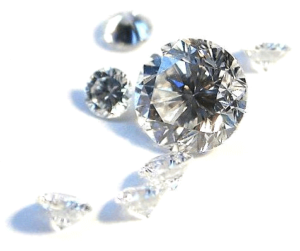
Cut –
Diamond Cut Quality – When jewellers judge the quality of a Diamond Cut, or “Make”, they often rate “Cut” as the most important of the “4 Cs.” The way a diamond is cut is primarily dependent upon the original shape of the rough stone, location of the inclusions, flaws to be eliminated, preservation of the weight and the popularity of certain shapes. Don’t confuse a diamond’s “Cut” with its “Shape”. Shape refers only to the outward appearance of the diamond and not how it is faceted.
The Importance of Cut Quality –
When a Diamond has a high quality cut (Ideal Cut), incident light will enter the stone through the Table and Crown, traveling toward the Pavilion where it reflects from one side to the other before bouncing back out of the Diamond’s Table toward the Observer’s eye (See Fig. 1). This phenomenon is referred to as “Light Return” (See Fig. 2) which affects a Diamond’s Brightness, Brilliance, and Dispersion. Any light-leakage caused by poor symmetry and/or cut proportions (off-make) will adversely affect the quality of light return.
The “Shallow Cut” and “Deep Cut” examples in Fig. 1 show how light that enters through the table of a Modern Round Brilliant diamond reaches the pavilion facets and then leaks out from the sides or bottom of the diamond rather than reflecting back to the eye through the table. Less light reflected back to the eye means less “Brilliance”. In the “Ideal Cut” example, most of the light entering through the table is reflected back towards the observer from the pavilion facets.
Keep in mind that the variance in proportions between an “Ideal Cut” (Ideal Make) and a “Fair, Poor, Shallow or Deep Cut” may be difficult to discern to the novice observer, although there will be a lack of Brilliance, Scintillation, and Fire. Cut quality is divided into several grades listed below.
- Ideal Cut
- Premium Cut
- Very Good / Fine Cut
- Good Cut
- Fair Cut
- Poor Cut
Cut Proportions –
In the past, the “Cut” quality of the “4 Cs” was the most difficult part for a consumer to understand when selecting a good diamond because a GIA or AGS certificate did not show the important measurements influencing cut (i.e. Pavilion and Crown Angle) and did not provide a subjective ranking of how good the Cut was. Only a trained eye could see the quality of a Good Cut. All of that has changed with the AGS Cut Grading system and GIA’s new “Cut Grading System”.
The Proportion and Symmetry of the cuts as well as the quality of the polish are factors in determining the overall quality of the cut. A poorly cut Diamond with Facets cut just a few degrees from the optimal ratio will result in a stone that lacks gemmy quality because the “Brilliance” and “Fire” of a diamond largely depends on the angle of the facets in relation to each other. An Ideal Cut or Premium Cut “Round Brilliant” Diamond has the following basic proportions according to the AGS:
- Table Size: 53% to 60% of the diameter
- Depth: 58% to 63% of diameter
- Crown Angle: 34 to 35 degrees
- Girdle Thickness: Medium to Slightly Thick
- Facets: 58 (57 if the Culet is excluded)
- Polish & Symmetry: Very Good to Excellent
The Girdle on a Modern Round Brilliant can have 32, 64, 80, or 96 facets which are not counted in the total number of Facets (58). The crown will have 33 Facets, and the Pavillion will have 25 facets. Other variations of the “Modern Round Brilliant” include the “Ideal Brilliant” which was invented by Johnson and Roesch in 1929, the “Parker Brilliant” invented in 1951, and the “Eulitz Brilliant” invented in 1972.
Poor Diamond Faceting and Symmetry

Due to the mathmatics involved in light refraction, a Round Brilliant cut that does not have the proper Proportions and Symmetry (off-make) will have noticeably less brilliance. Common cutting problems can occur during the Faceting process, when one incorrect Facet Angle can throw off the Symmetry of the entire stone. This can also result in the undesirable creation of Extra Facets beyond the required 58. The chart below shows several common problems to look for.

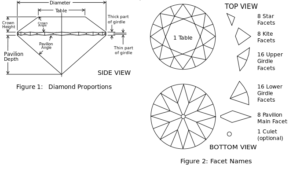

CLARITY
All of the grades of Diamond Clarity shown in the table below reflect the appearance of inclusions within the stone when viewed from above at 10X Magnification Higher magnifications and viewing from other angles are also used during the Grading Process. In “Colourless” Diamonds, Darker inclusions will tend to create the most significant drop in Clarity Grade. In Fancy-Coloured Diamonds, Light or Pale Inclusions may show greater relief, making them more apparent, causing a greater drop in grade.

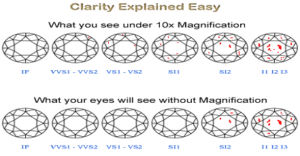
Diamond Clarity Designations
- FL – “Flawless” no inclusions at 10 x magnification
- IF – “Internally Flawless” no inclusions at 10 x mag. – small blemishes
- VVS-1 – “Very Very Small” inclusions hard to see at 10 x magnification
- VVS-2 – “Very Very Small” inclusions. VVS1 better than VVS2
- VS-1 – “Very Small” inclusions visible at 10 x mag. – not naked eye
- VS-2 – “Very Small” inclusions VS1 is better grade than VS2
- SI-1 – “Small” or “Slight” Inclusions or “Imperfections” may be “eye clean”
- SI-2 – “Small” or “Slight” Inclusions or “Imperfections” visible to naked eye
- SI-3 – Inclusions large and obvious, little or no brilliance
- I1 to I3 – Imperfect, with large Inclusions, fractures, and flaws
Color
Most all Natural Diamonds contain small quantities of Nitrogen Atoms that displacing the Carbon Atoms within the Crystal’s Lattice Structure. These Nitrogen Impurities are evenly dispersed throughout the Stone, absorbing some of the Blue Spectrum, thereby making the Diamond appear Yellow. The higher the amount of Nitrogen Atoms, the Yellower the stone will appear. In determining the Colour Rating of a Diamond, the Gemological Institute of America uses a scale of “D” to “Z” in which “D” is totally Colourless and “Z” is Yellow.

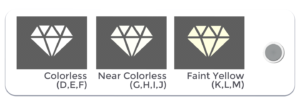
 Colourless (D, E, F)
Colourless (D, E, F)
Highest-quality color grade a diamond can receive. A D-color diamond is extremely rare and emits unrivaled brilliance. Containing very minute traces of color, an E or F-color rated diamond emits a high level of brilliance and sparkle.
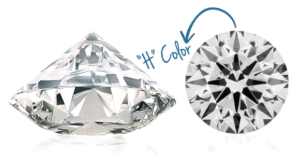 Near Colorless (G, H, I, J)
Near Colorless (G, H, I, J)
Containing noticeable color only when compared to higher color grades, G or H Colour Diamonds provide an Excellent Value. Whereas an I or J – color Diamond typically appears colourless to the untrained eye yet contains slightly detectable colour.
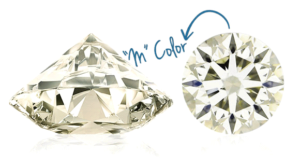 Faint Yellow (K ,L, M)
Faint Yellow (K ,L, M)
Faint color is noticeable. Even with the presence of color, these grades of diamonds can emit fire and beauty. Consider selecting a lower color when setting in yellow gold as color will be not as apparent.
Diamond Color Designations
- D, E, F – Colourless (Pure White)
- G, H, I, J – Near Colourless
- K, L, M – Faint Yellow or Brown
- N, O, P, Q, R – Very Light Yellow or Brown
- S, T, U, V, W, X, Y, Z – Light Yellow or Brown
Carat (Weight)
Carat weight is one of the 4 C’s, representing the four variables that are used to calculate the Quality and Value of a Diamond. Both Rough and Cut Diamonds are separated and graded based on these four characteristics. As a consumer, your first step in shopping for a Diamond should be to learn and understand the “4 C’s” diamond grading system.
Balancing Cut and Weight
A Diamond or Gemstone’s “Carat” designation is a measurement of both the size and weight of the stone. One “Carat” is a unit of mass that is equal to 0.2 grams (200 milligrams or 3.086 grains) or 0.007 ounce.
A metric “Carat” is defined as 200 Milligrams. Each carat can be partitioned into 100 ‘Cents’. This allows very precise measurements to the hundredth decimal place.
A jeweller may describe the weight of a diamond below one carat by its ‘cents’ alone. For instance, the jeweller may refer to a diamond that weighs
- 25 carats as a ‘twenty-five cents’
- 70 carats as ‘seventy cents’
Diamond weights greater than one carat are expressed in carats and cents.
- 80 carat stone would be described as ‘one carat and eighty cents’
- 44 carat stone would be described as ‘one carat and forty four cents’
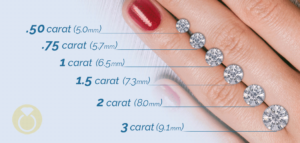

When a single piece of jewellery has multiple stones, the total mass of All Diamonds or Gemstones is referred to as “Total Carat Weight” or “T.C.W.” The word “Carat” is derived from the Greek word Keration, or “Seed of the Carob”. In ancient times, Carob seeds were used to Counterbalance Scales, and as a benchmark weight due to their predictably uniform weight.
Carat Weight & Price:
Mined from deep within the layers of the Earth’s crust, most Rough Diamonds are either too small or too inferior in Quality to produce the Lustrous, Polished products demanded in the Fine Jewellery market. Consequently, the production of a Single, One-Carat Diamond can require the mining of up to One Million Rough Diamonds. The process of finding a larger Diamond is even more intensive. The rarity of Larger, High-Quality Diamonds has resulted in significant price escalations between sizes. For instance, a One-Carat diamond can command four to six times more than a Half-Carat Diamond. The price of a Diamond continues to increase as its size gets Bigger and Bigger.
